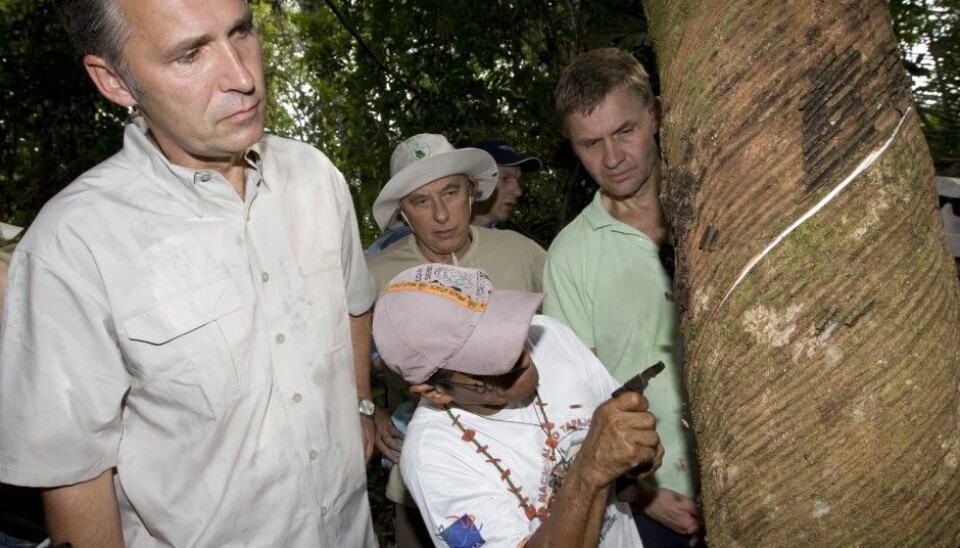
Behind-the-scenes look at Norway’s US$1.6 billion rainforest initiative
An unusual convergence of political and environmental interests led Norwegian Prime Minister Jens Stoltenberg to promise billions from Norway to protect rainforests at UN climate conference.
Denne artikkelen er over ti år gammel og kan inneholde utdatert informasjon.
Norway is by far the largest contributor to rainforest conservation through a United Nations programme called REDD +, with contributions totalling US$1.608 billion as of 2015, or more than 8 times the next largest contributor, Australia.
You would think that the decision to contribute such an enormous sum would have required extensive negotiations and lots of horse-trading in the halls of the Norwegian Storting.
But not so. The agreement on the decision came, remarkably, after just a few months of negotiations in 2007.
“This is an example of a great victory for environmental organizations. The pace of the political process was sensational, as sensational as the size of the contribution. Norway is the world's leading donor, and the decision to make this contribution was made in just a couple of months,” says researcher Erlend Hermansen from CICERO, the Center for International Climate and Environmental Research based in Oslo.
Turbo lobbying
When then-Prime Minister Jens Stoltenberg walked up to the podium at the UN Climate Summit in Bali in 2007 and announced that Norway would contribute NOK 300 billion (US$500 million) annually to prevent tropical deforestation, it wasn’t exactly his idea. Instead, the proposal had been hatched a few months earlier by two men, both named Lars.
The first Lars was Lars Haltbrekken from The Norwegian Society for the Conservation of Nature/Friends of the Earth. His partner in this effort was Lars Løvold from Rainforest Foundation Norway.
“It's impressive what they managed to achieve,” Hermansen says. “This decision probably represents a Norwegian record in ultrafast political climate agreements. It also represents a world record for this kind of monetary contribution.”
Behind the scenes
Hermansen and researcher Sjur Kasa at Hedmark University College have taken a behind-the-scenes look at the political machinations that lay behind the agreement, which Hermansen documents in an article just published in Environmental Politics.
“I do not know of any other examples of political lobbying that have led to such a major decisions in such a short time,” says Hermansen. “But the organizations involved used democratic means to advance their case. They were also helped by a number of circumstances that made the decision fit Norway very well.”
The letter that started the ball rolling
It took just a one-and-a-half page letter, written in September 2007 by Lars Haltbrekken and Lars Løvold, to start the process in motion. The two men proposed that Norway commit to give billions to rainforest protection.
There were hearings in the Storting, and eventually a group of conservatives and liberals embraced the concept. Brazilians were flown to Norway to testify in front of the Storting to describe the importance of protecting the rainforest.
In November, the opposition parties in the Storting challenged the ruling parties to sign a climate agreement (called the “climate settlement”), which would include rainforest protection as part of the package.
In December Prime Minister Stoltenberg promised the UN Climate Conference in Bali a record donation from Norway—up to NOK 3 billion annually from 2008 to 2012. In January the proposal won bipartisan endorsement and was adopted by the Storting as part of Norway’s climate settlement.
A political window
Hermansen said that Haltbrekken and Løvold took advantage of what political scientists call a “political window”, where a perfect storm of converging events sets the stage for quick political action.
In this case, he said, the two men were the architects behind the idea, and followed up with intense lobbying which quickly led to an agreement. But at the same time, a number of world events helped create the context that would allow the agreement to come to pass.
For example, the Intergovernmental Panel on Climate Change, the IPCC, won the Nobel Peace Prize in 2007 along with Al Gore.
And the year before, the Stern Review on the Economics of Climate Change, a 700-page report prepared for the British Government by economist Nicholas Stern, concluded that rainforest protection is one of the most cost-effective ways to cut greenhouse gas emissions.
And Løvold and Haltbrekken’s letter was sent just three days after Jens Stoltenberg had been at a high-level meeting on climate at the UN’s headquarters in New York, along with more than 80 other heads of state.
A cost-effective measure
Another important reason the measure won support in Norway is that it is very cost effective, Hermansen said.
“It is very expensive to cut (greenhouse gas emissions) in Norway, partly because we already have a lot of renewable energy from hydroelectric power. Making emission cuts in the transport sector and the oil and gas sector are often seen as expensive. The argument is that you get more emission cuts abroad for the same amount of money,” he said.
It is also very rare in international climate negotiations for countries to actually put money on the table. The idea was that if Norway made this promise, that it would help to speed up negotiations, he said.
You can read more about where Norway’s contributions are being spent on the Ministry of Climate and Environment’s website.
-------------------------------------
Read the Norwegian version of this article at forskning.no


































